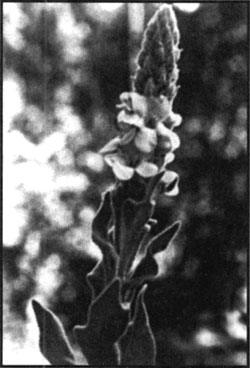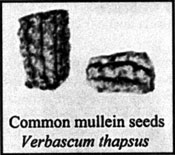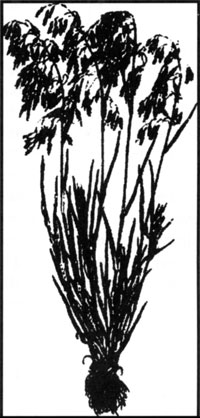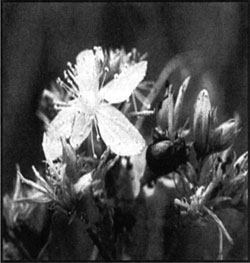Weeds: The New Arrivals
Crater Lake National Park will celebrate its centennial in 2002, so it is worth reflecting on the past century of human use. Some present-day travelers view this national park as a vignette of the regional landscape that existed when Europeans first encountered the native peoples. Changes occurred in the local flora, however, as the new arrivals became more numerous along with their domestic livestock. Hidden in the hay and other livestock foods were seeds of plants not native to this region. During the late nineteenth century human travel accelerated and soon became a primary vehicle for alien plants to extend their range into new habitats, especially in campgrounds and along roads where soils were exposed and churned.
The number of successful alien or weedy plants in Crater Lake National Park is relatively small compared to other park areas that have sustained major human-induced disturbances over long periods. Important reasons for the low numbers here are the abbreviated growing season and the attendant snow pack that covers the ground for long periods. Disturbed habitats at the park are mostly limited to visitor use areas, including road and trail margins. These areas are in a continual state of disturbance and will always harbor an array of weeds that have naturalized and reproduce successfully in their new habitats. Along trails, pack stock or other livestock bring in alien seeds and thus introduce weeds to trail corridors and meadows. There was sheep grazing in the high meadows prior to Crater Lake gaining the status of a national park, and trespass cattle grazing has also occurred intermittently. Recently burned forest areas are also susceptible to weed invasions, especially near roadways where seed sources for weeds are readily available. As an example, common plantain (Plantago major) is believed to have entered the Panhandle area via deer and elk trails originating from cut over lands lying outside the park.
What is a weed?
 Mullein. |
The word “weed” suggests an undesirable plant, a nuisance, something unsightly. These characterizations are all subjective, of course. Sometimes the word “weed” is a misnomer such as in fireweed (Epilobium angustfolium), a native species and not a weed. One simple definition has it that a weed becomes a weed by growing in a place where people desire something else. Often the word “weed” is used to suggest a plant out of place; that is, one not planted by the gardener. As Ralph Waldo Emerson wrote, “What is a weed? A plant whose virtues have not yet been discovered.” In the biological sense, however, a weed is very much in place because of its myriad adaptations made to insure survival.
As the late Ron Taylor said, “The weediness of a plant depends on the time and place that it is found: the attractiveness is in the eyes of the beholder.” Some weeds produce showy, colorful flowers and may be very attractive to the traveler who is blissfully unaware that these plants are relatively new arrivals not seen in places like the park a century ago. Exotic grasses, for example, tend to blend in visually with native species and remain inconspicuous except to the keen observer.
 Common mullein seeds, Verbascum thapsus. |
Biologically speaking, a weed is a relatively aggressive, competitive plant, and generally not native to the region. Weeds are highly adaptable and have a diversity of survival strategies; the common dandelion (Taraxacum officinale), for instance, does not require pollination or fertilization to produce seed. Cheatgrass (Bromus tectorum) is a quintessential weed. It was first observed in western North America about 1916 and has invaded rangelands throughout the west in only a few decades. Fortunately it does provide some nutritious forage before flowering, but this species has the potential to spread rapidly. Cheatgrass gains a competitive advantage by germinating and beginning its growth in the autumn. When indigenous species germinate in the spring, cheatgrass plants are already established and growing vigorously. Since this annual grass matures early and cures by the first part of summer, it has become a major flash fuel type in many range habitats. The fire regime in many western habitats has been thus altered by the introduction of this grass.
Despite their being firmly rooted, weeds have mobility through their propagules (seeds and vegetative tissues) that may be carried to new localities by hikers, pets, domestic livestock, and vehicles. Once weeds have become established, a weed seedbank develops. Seedbanks may contain vast libraries of seed adapted to a wide range of environmental conditions and ready to germinate once appropriate conditions arise. Buried weed seeds may remain viable for tens of years or even several hundred years. Legume seeds are among the record holders for longevity and in a few cases have approached a millennium.
Weed control
 Cheatgrass. |
Roadsides are highly disturbed areas and they will continue to be disturbed through maintenance activities and traffic use. Continual or repeated disturbance creates conditions that invite invasion and repeated re-invasion by weeds. Use of herbicides along roadsides may be toxic to water supplies and wildlife, and such toxic chemicals do not accomplish the objective of long-term elimination of weeds. Roadside treatment with herbicides can actually favor weeds by creating conditions that make it very difficult for native species to establish and maintain populations.
One potentially effective method of weed control is to employ a biological agent that is host-specific. It could be aimed at weakening the target weed’s growth or adversely affecting its seed production. The primary natural enemies include arthropods, vertebrates, and pathogens such as fungi, viruses, bacteria, and nematodes. An example is the biological control of St. Johns-wort (Hypericum perforatum), which invaded extensive areas of rangeland but has now been contained through the introduction of several insects: the beetles Agrilusand Chrysolina, the moth Aplocera, and the aphidAphis. Roadside populations of St. Johns-wort still remain obvious since the insects are not as effective along road margins.
Another easily seen weed along road margins is common mullein (Verbascum thapsus),conspicuous because of its height that often exceeds one meter. Seeds of this weed actually made their way to Wizard Island, and at least one mullein plant developed near the boat dock. Mullein seeds are tiny and resemble squares in shape, having a textured surface that would help the seeds cling to clothing or fur. Other weeds to arrive on Wizard Island and the western shoreline of Crater Lake are woods groundsel (Senecio sylvaticus) and two thistles: Canada thistle (Cirsium arvense) and bull thistle (C. vulgare).
Other national park areas provide a more in-depth learning experience with the weedy elements of the flora. Many are not aggressive aliens displacing natives, but there are notable exceptions worth examining. Coastal regions with long, mild growing seasons often have more serious weed problems than mountainous areas. Just south of Crescent City, California, lies an old coastal prairie described in the diaries of Jedediah Smith in 1828. He remarked that the site was a plentiful source of forage for his horses, for at the time this prairie was entirely composed of indigenous grasses and forbs (herbaceous flowering plants). Little of the original native flora exists in this prairie today due to 150 years of disturbance (including relatively recent agricultural use occurred prior to these lands becoming part of Redwood National Park).
 St. Johnswort (Hypericum perforatum) grazed by a Chrysolina beetle. |
One of the first natural resource projects carried out at Redwood National Park was focused on containing the spread of tansy ragwort (Senecio jacobdea), a European weed toxic to livestock. Tansy ragwort became very aggressive along the Pacific Northwest coast during the early 1980s. Some containment was achieved through mowing which prevented prolific seed production. The introduction of the tansy flea beetle (Longitarsus jacobaeae) and the cinnabar moth caterpillar(Callimorpha jacobaeae) proved the only effective control since both are herbivores that greatly stress the plants. Once these biological control agents gained success, however, the niche formerly occupied by the tansy ragwort was quickly filled with oxeye daisy (Chrysanthemum leucanthemum), another alien plant. Both of these weeds are very attractive in flower, and they produced a grassland dominated by yellow (tansy ragwort) followed by white (oxeye daisy). Visitors to the coastal beaches admired these plants despite them being aggressive alien invaders.
Surveillance
A weed monitoring protocol focused on disturbed areas is essential in a park’s vegetation management program. As long as disturbance occurs through travel activities, invasive weeds and other alien new arrivals are inevitable. To date, small and manageable populations of the following recent arrivals are known to occur in Crater Lake National Park: cheatgrass, smooth brome (Bromus inermis), bulbous bluegrass (Pod bulbosa), mullein, spotted knapweed (Centaurea maculosa), and Dalmatian toadflax (Linaria dalmatica). Such small infestations may be hand pulled or mowed until the seedbank is reduced. Of all weed species that occur in the park, there are four which have the potential to spread rapidly and may be regarded as aggressive problem weeds: cheatgrass, bull thistle, St Johns-wort, and spotted knapweed.
Co-existing with weeds requires a practical, effective, and environmentally safe means of keeping their numbers minimized. Understanding future weed management issues and dynamics will depend, in part, on our definitions and a practical weed control program.
References
Ronald J. Taylor, Northwest Weeds: The Ugly and Beautiful Villains of Fields, Gardens, and Roadsides. Missoula, MT: Mountain Press, 1990.
Peter F. Zika, Annotated checklist of Vascular Plants in Crater Lake National Park. Portland: The Nature conservancy, 1995.
Ron and Joy Mastrogiuseppe are founders of the Crater Lake Institute. Their love affair with Crater Lake began by collaborating on a study of sedges in the park.

